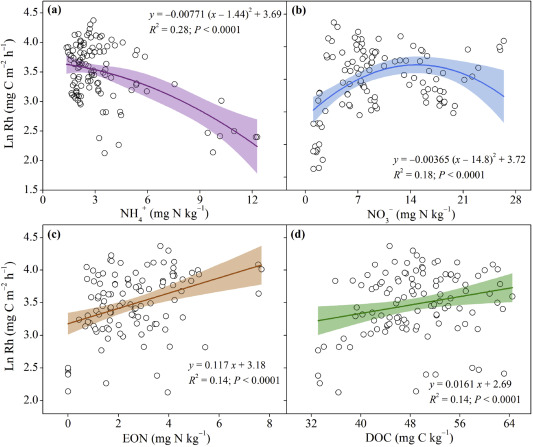Zengming Chen, Yehong Xu, Yujie He, Xuhui Zhou, Jianling Fan, Hongyan Yu, Weixin Ding. Nitrogen fertilization stimulated soil heterotrophic but not autotrophic respiration in cropland soils: A greater role of organic over inorganic fertilizer. Soil Biology and Biochemistry,2018,116: 253–264
Abstract
Nitrogen (N) enrichment may have considerable effects on soil carbon (C) fluxes. However, the responses of soil respiration (Rs) and especially its heterotrophic (Rh) and autotrophic (Ra) components to N fertilization remain controversial, and evidence on the impacts of N form and addition rate is lacking. We conducted a field experiment in a maize cropland in northeast China to investigate the responses of Rs, Rh, and Ra to different inorganic (IN) and/or organic (ON) N fertilization regimes, including no N addition (CK) and five N-fertilized treatments with a gradient ratio of IN to ON at 4:0 (IN4), 3:1 (IN3), 2:2 (IN2), 1:3 (IN1), and 0:4 (IN0). Annual Rs was higher in the N-fertilized treatments than CK, but only significantly so for IN1. Fertilization increased Rh from 118 to 123–149 g C m−2 with significant effects observed in all ON-fertilized treatments. However, fertilization did not affect Ra which varied at a range of 63–71 g C m−2. Rh was suppressed by excessive supply of ammonium and nitrate which was more effectively increased by IN than ON fertilization, but always increased with increasing extractable organic N and dissolved organic C which were higher in the treatments applied with more ON. Accordingly, a greater role of ON over IN fertilization was found in stimulating Rh. Rs (2.76–3.81) and Rh (2.67–3.28) had higher Q10 values than Ra (1.51–2.05). Application of N fertilizer, especially IN, enhanced the Q10 value of Ra, but decreased those of Rs and Rh. Unexpectedly, grain yield and aboveground biomass were reduced by IN fertilization, but increased with increasing ON fertilizer application rate. Overall, our findings highlight the significance of the form and addition rate of N fertilizer on soil C cycling and its feedback to climate change under N enrichment.








